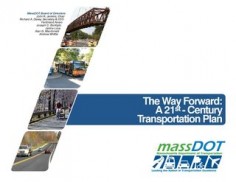By André Leroux, Executive Director
April 3, 2013
The Legislature dropped its long-awaited transportation plan yesterday. It’s the first time I ever felt disappointment at $500 million. I believed that we had the chance to set a visionary course for a post-Big Dig transportation system. It’s like having the opportunity to invest in an exciting new business, but instead you just pay off one of your credit cards.
That being said, it’s important to acknowledge some important victories that we asked for. In terms of good news, the Legislature’s proposal:
- Stops the practice of borrowing $234 million every year to cover salaries;
- Closes the MBTA’s structural deficit for FY14 without fare increases or service cuts;
- Forward funds the Regional Transit Agencies around the state and provides a small increase in funding;
- Provides a bump for local transportation projects (basically road re-paving and some sidewalks);
- Finally raises the gas tax for the first time since 1991 and indexes it to inflation; and
- Does these things without further burdening low-income residents (at least this year).
But the fact remains that it will cost $19 billion just to repair existing roads, bridges, and rails. This plan has no way to pay for that. Nor is there funding for regional projects that will boost local economies and connect more people to jobs. Nor increasing walking, biking and public transportation around the state in any significant way. Even more troubling, it looks like there is a built-in reliance on hefty fare increases in future years
Why go so far and yet not finish the job? There is no question that we need to modernize and improve transportation. Families and businesses are losing time and money to a decrepit, congested system. Our economy can’t grow if we don’t increase capacity and connect the state better.
Imagine what life would be like today if we had never transformed transportation in the 1950s through the interstate system. How successful do you think we would be if we all had to use Route 9 to get from one end of Massachusetts to another? I can say with confidence that we would have far fewer jobs and far less mobility.
Now it’s 60 years later. Our society and our economy are transforming, but our thinking about transportation remains in the 1900s.
Automobiles are just one piece of the puzzle, and it’s declining. Today’s economy is driven instead by great places that attract people and investment, and which foster creativity and innovation. MassDOT has finally realized this, and set an inspiring goal of tripling the share of walking, biking and public transportation in the state. Now we need a financing plan that can enable this new generation of infrastructure to materialize.
Already, an increasing number of people are isolated because they can’t afford a car and the alternatives are inadequate. One out of eight households in the state doesn’t have a car, and fewer young people are getting drivers’ licenses. These trends will only become stronger in the coming years. We are becoming less mobile as a society because we have old-fashioned notions about getting around, and we are becoming less competitive and losing jobs to other places with better infrastructure.
There is another way. Businesses and young adults especially must speak for the future. The Legislature needs to do better.
Click here for more information.



